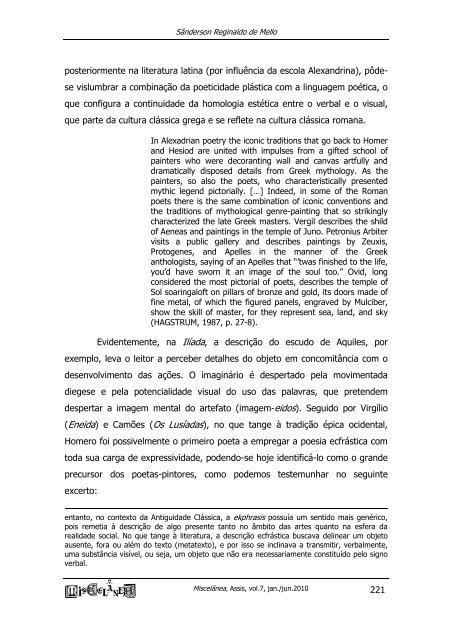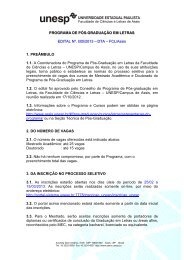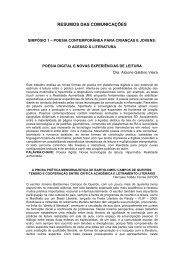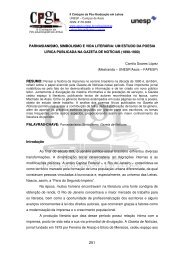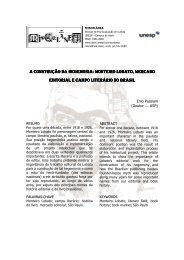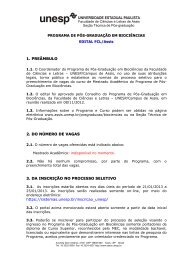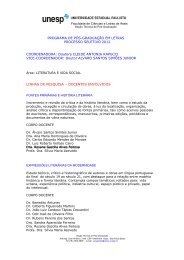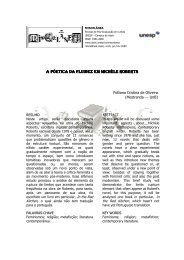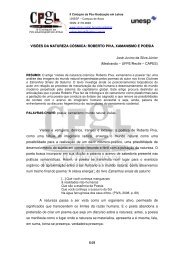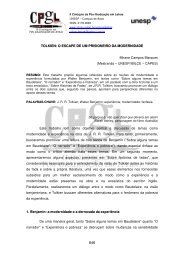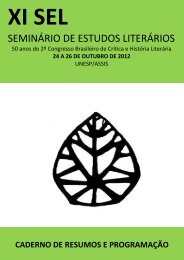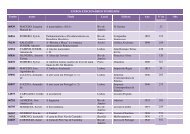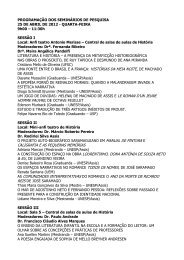O "ut pictura poesis" e as origens crÃticas da ... - UNESP-Assis
O "ut pictura poesis" e as origens crÃticas da ... - UNESP-Assis
O "ut pictura poesis" e as origens crÃticas da ... - UNESP-Assis
Create successful ePaper yourself
Turn your PDF publications into a flip-book with our unique Google optimized e-Paper software.
Sânderson Reginaldo de Melloposteriormente na literatura latina (por influência <strong>da</strong> escola Alexandrina), pôdesevislumbrar a combinação <strong>da</strong> poetici<strong>da</strong>de plástica com a linguagem poética, oque configura a continui<strong>da</strong>de <strong>da</strong> homologia estética entre o verbal e o visual,que parte <strong>da</strong> cultura clássica grega e se reflete na cultura clássica romana.In Alexadrian poetry the iconic traditions that go back to Homerand Hesiod are united with impulses from a gifted school ofpainters who were decoranting wall and canv<strong>as</strong> artfully anddramatically disposed details from Greek mythology. As thepainters, so also the poets, who characteristically presentedmythic legend pictorially. […] Indeed, in some of the Romanpoets there is the same combination of iconic conventions andthe traditions of mythological genre-painting that so strikinglycharacterized the late Greek m<strong>as</strong>ters. Vergil describes the shildof Aene<strong>as</strong> and paintings in the temple of Juno. Petronius Arbitervisits a public gallery and describes paintings by Zeuxis,Protogenes, and Apelles in the manner of the Greekanthologists, saying of an Apelles that “’tw<strong>as</strong> finished to the life,you’d have sworn it an image of the soul too.” Ovid, longconsidered the most pictorial of poets, describes the temple ofSol soaringaloft on pillars of bronze and gold, its doors made offine metal, of which the figured panels, engraved by Mulciber,show the skill of m<strong>as</strong>ter, for they represent sea, land, and sky(HAGSTRUM, 1987, p. 27-8).Evidentemente, na Ilía<strong>da</strong>, a descrição do escudo de Aquiles, porexemplo, leva o leitor a perceber detalhes do objeto em concomitância com odesenvolvimento d<strong>as</strong> ações. O imaginário é despertado pela movimenta<strong>da</strong>diegese e pela potenciali<strong>da</strong>de visual do uso d<strong>as</strong> palavr<strong>as</strong>, que pretendemdespertar a imagem mental do artefato (imagem-eidos). Seguido por Virgílio(Enei<strong>da</strong>) e Camões (Os Lusíad<strong>as</strong>), no que tange à tradição épica ocidental,Homero foi possivelmente o primeiro poeta a empregar a poesia ecfrástica comto<strong>da</strong> sua carga de expressivi<strong>da</strong>de, podendo-se hoje identificá-lo como o grandeprecursor dos poet<strong>as</strong>-pintores, como podemos testemunhar no seguinteexcerto:entanto, no contexto <strong>da</strong> Antigui<strong>da</strong>de Clássica, a ekphr<strong>as</strong>is possuía um sentido mais genérico,pois remetia à descrição de algo presente tanto no âmbito d<strong>as</strong> artes quanto na esfera <strong>da</strong>reali<strong>da</strong>de social. No que tange à literatura, a descrição ecfrástica buscava delinear um objetoausente, fora ou além do texto (metatexto), e por isso se inclinava a transmitir, verbalmente,uma substância visível, ou seja, um objeto que não era necessariamente constituído pelo signoverbal.Miscelânea, <strong>Assis</strong>, vol.7, jan./jun.2010 221


